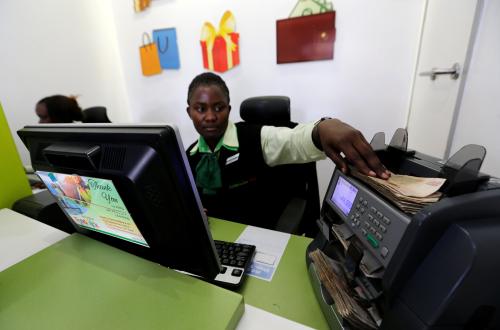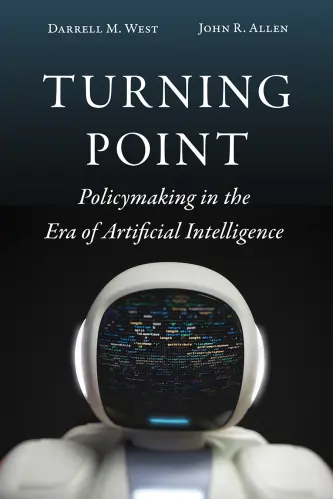This year’s Financial Inclusion Week, held from October 30 to November 3, has fostered a global conversation surrounding ways that new products and partnerships are advancing engagement with financial services, particularly among underserved populations. Events hosted around the world have centered on topics such as the role of financial technology (“fintech”) in advancing financial inclusion, the business case for promoting financial literacy, and approaches to implementing financial capability training for students, among many others.
These themes closely align with several of the key findings from the latest Brookings Financial and Digital Inclusion Project (FDIP) report, published in August 2017. In this post, we explore two of these key findings surrounding fintech and cybersecurity. For more information on the key findings from the annual FDIP reports, read the 2015, 2016, and 2017 reports and check out the associated interactive scorecards.
As we highlight in the 2017 FDIP report, fintech possesses tremendous potential to accelerate progress toward financial inclusion. Startups, established tech companies, and other fintech entities can leverage technology to reduce operating costs, foster innovation, and advance customer-centric design and offerings, which can in turn enable financial service providers to cost-effectively scale their outreach to underserved market segments and enhance opportunities for underserved individuals to engage with products that suit their financial needs.
Recent studies suggest that many incumbent service providers have recognized the growing prevalence of fintech, as well as the potential opportunity costs of not engaging with fintech entities. An April 2017 report by multinational professional services network PwC found that 88 percent of financial services companies surveyed expressed concern that they could lose revenues to standalone fintech companies, and about 82 percent of financial services respondents planned to increase fintech partnerships in the next three to five years.
For companies that choose to engage in these partnerships, there are a number of models to learn from, including several described in a July 2017 report by the Center for Financial Inclusion at Accion and the Institute of International Finance. Using fourteen case studies identified as best-case scenarios, the authors of the report affirm that partnerships between traditional financial companies and fintechs can be complementary, rather than competitive.
Below, we highlight two examples of organizations that are leveraging technology and cross-sectoral partnerships to advance financial access and usage among underserved groups.
The first example is AID:Tech, a company that uses blockchain technology to advance financial and social inclusion by offering a platform for clients to issue digital identity profiles for end-users. These profiles also serve as virtual wallets for the delivery of in-kind aid, remittance payments, assistance packages, and other digital entitlements dispersed by international development banks, charities, governments, and private enterprises. For example, AID:Tech’s platform has been used to successfully deliver aid to Syrian refugees.
Given that more than 65 million people—including more than 22 million refugees—were forcibly displaced worldwide as of 2016, there is considerable value in platforms that can help facilitate cost-effective, transparent, timely payments to these individuals. The digital identity aspect of the platform is also important, as the lack of identity documents has been widely cited as a key obstacle to the financial and social inclusion of forcibly displaced persons. Of course, these concerns extend beyond refugee populations: An estimated 2.4 billion people around the world lack formal identification records, and more than two billion adults are excluded from the formal financial system.
Pivoting from financial access to usage, the second example is that of third-party service provider Juntos, which has partnered with financial service providers to offer tailored SMS messages that enable customers to learn about banking services, ask questions about those services, and receive encouragement as they move toward their financial goals. As noted in a 2016 report by the Center for Financial Inclusion at Accion, Juntos has collaborated with traditional financial institutions such as Mexican bank BBVA, as well as nonbank entities such as Tanzanian mobile money provider Tigo Pesa.
Products and services that help advance awareness and understanding of quality, affordable financial services (financial literacy) and build skills/encourage behaviors that support financial health (financial capability) are valuable components of the financial inclusion landscape. While the examples above reflect promising developments at the intersection of fintech and financial inclusion, significant opportunities remain for fintech players to support financial capability efforts, particularly for underserved customers.
Moreover, while fintech partnerships offer plenty of advantages for providers and customers, these partnerships will only be sustainable if the systems and processes undergirding them are secure. In February 2017, the Brookings FDIP team hosted a roundtable to explore the issue of cybersecurity and inclusivity within the global financial ecosystem. During the roundtable, participants expressed concerns that budget constraints, competing policy priorities, insufficient technical understanding, and a lack of awareness surrounding cybersecurity issues all contribute to insufficient investments in cybersecurity measures throughout the financial ecosystem.
The FDIP team provided several recommendations in the 2017 FDIP report aimed at helping to mitigate these challenges. First, policymakers, regulators, fintech entities, civil society organizations, traditional financial institutions, and other players in the financial inclusion space should amplify discussions and knowledge-sharing surrounding cybersecurity obstacles and approaches in order to facilitate technical assistance and identify best practices.
Additionally, we encourage financial service providers to ensure that the development of innovative products is coupled with stringent testing and monitoring of those products as early and often as possible. On the regulatory side, regulators and policymakers should consider the use cases and technologies involved when developing cybersecurity guidance.
Finally, since many financial systems are outdated and/or centralized, financial service providers (and other entities that house financial data) should invest in strengthening the security of these systems in order to protect financial integrity and stability.
By advancing the security of financial platforms; fostering dialogue among industry, government, and civil society representatives; and leveraging technology to design and disseminate client-centric financial offerings, financial inclusion stakeholders can help accelerate progress toward equitable access to and usage of quality, affordable financial services.
The Brookings Institution is committed to quality, independence, and impact.
We are supported by a diverse array of funders. In line with our values and policies, each Brookings publication represents the sole views of its author(s).













Commentary
Financial inclusion week 2017: Exploring the utility and security of fintech products and partnerships
November 3, 2017